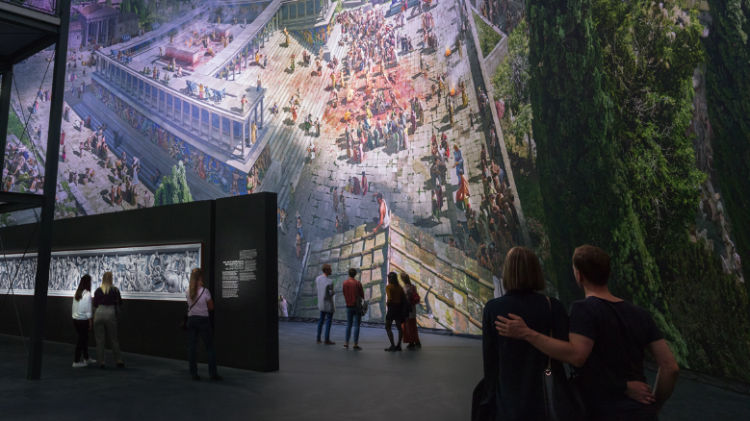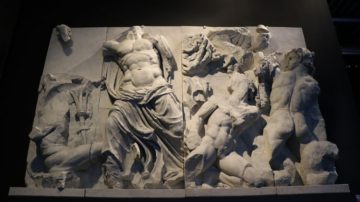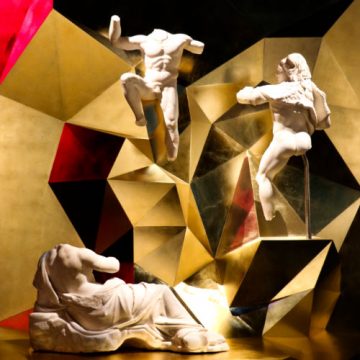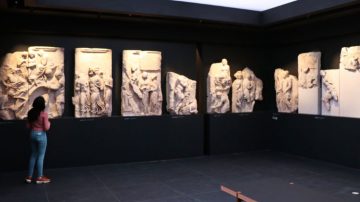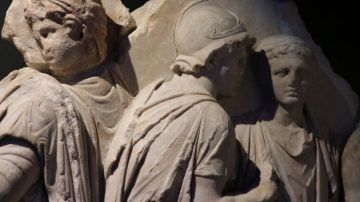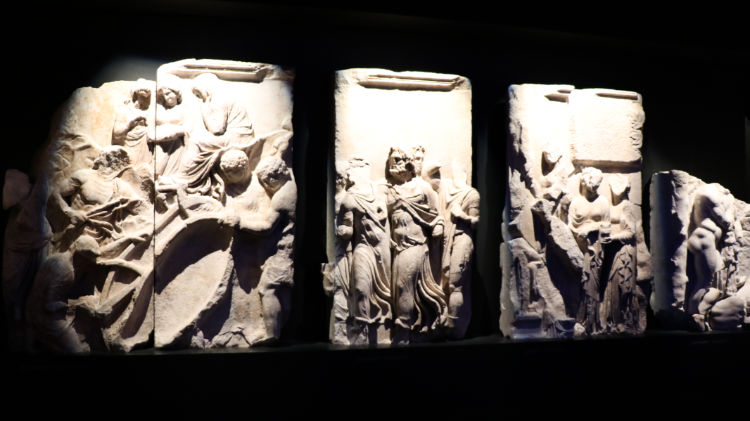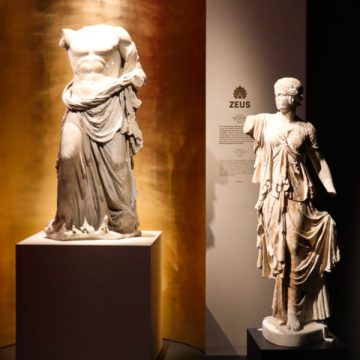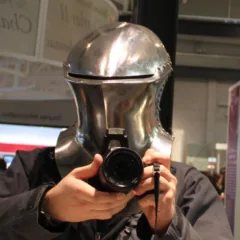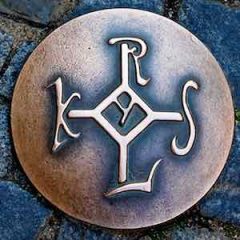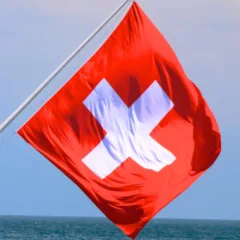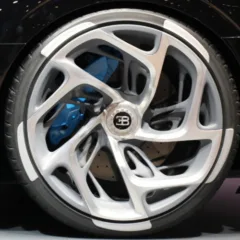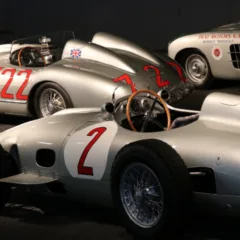Pergamonmuseum Das Panorama allows visitors a close-up view of sculptures and reliefs from the Pergamon Altar and Yadegar Asisi’s panoramic painting in Berlin.
Das Panorama is a special temporary exhibition in Berlin showing some of the sculptures and frieze reliefs of the Pergamon Altar while the Hellenic section of the Pergamon Museum remains closed for renovation. Around 80 statues from antiquity are on display while the Panorama refers to a huge 360° painting by Yadegar Asisi of a day in the life of the Greek metropolis Pergamon. The temporary exhibition will be in place until 2025. Time-slot reservation tickets are available online around four weeks in advance of visits. The Pergamon Altar Hall in the main museum will reopen in spring 2027 while the whole Pergamon Museum is closed since October 2023.
Pergamon Altar on Berlin’s Museum Island
The Pergamon Altar from Greek antiquity is among the best-known works in the vast collection of the Berlin State Museums. It was originally constructed around 180 and 160 BC in the Greek city Pergamon and was considered by the Romans to be among the highest artistic achievements of ancient Greece.
A large section of the Pergamon Altar was reconstructed in the Pergamon Museum in Berlin to show off the friezes and many statues in their original position. These were excavated in modern-day Türkiye towards the end of the 19th century,
Parts of two friezes from the Pergamon Altar are exhibited in Berlin:
- The Great Frieze from the outside of the altar is 2.3 m high and 120 m long and uses around 100 statues to depict an epic battle between the giants and the Olympian gods.
- The smaller Telephus Frieze was placed on the courtyard walls that surrounded the open-air sacrificial altar platform. It is 1.58 m high and explains the foundation myth of the city founder Telephos, son of Heracles. Of the original 74 marble slabs, 47 survived.
Pergamon Museum. Das Panorama in Berlin
The Pergamonmuseum is currently undergoing a major renovation — the entire museum closed in October 2023. As a result, the Pergamon Altar cannot be seen and will only again be fully accessible to visitors by 2027.
In the meantime, many of the statues are displayed in the special Panorama exhibition. It comprises of two main sections:
- A huge 360° panoramic painting representing Pergamon in antiquity; and
- Around 80 sculptures and marble relief panels from Pergamon.
Yadegar Asisi’s 360° Panorama Painting of Pergamon
At the core of the temporary Pergamonmuseum exhibition is a 3,100 sq m circular representation of the Greco-Roman city Pergamon. This huge 360° painting by Yadegar Asisi shows the city in AD 129 on the festival of Dionysus when the Pergamon Altar would have played a central role. The original painting was enlarged and reproduced on material measuring 30 by 104 m.
A light and sound show allows visitors to see Pergamon through a day cycle. A five-story central tower with platforms allows for a better bird’s eye view of the city. An elevator is available if necessary.
The painting succeeds in placing the Pergamon Altar in context with other monumental structures such as the theater, the temple of Dionysus, the sanctuary of Athena, and the Trajaneum. The Pergamon Altar was not a temple – it was a place for the slaughter of animals and offering by burning to the gods on the sacrificial altar.
The painting also shows the friezes in color, as they originally would have been. Plaster casts show part of the surviving frieze with a large drawing showing what the completed relief probably looked like.
Statues from Antiquity in the Pergamon Das Panorama Exhibition
Impressive as the Asisi painting is, the main reason for visiting Pergamonmuseum: Das Panorama exhibition is still to see the magnificent Greek sculptures. Around 80 items are on display – mostly arranged according to geographical origin.
Statues of various rulers, gods, and goddesses are on display – mostly with golden backdrops. A few magnificent mosaics show sumptuous Pergamon palace interiors.
An impressive group of women statues was placed on the terrace of the Pergamon Altar. Changing light effects allows visitors to see these draped statues to best effect in different light conditions.
The most impressive grouping is the 47 surviving marble slabs from the smaller frieze from the Pergamon Altar. It tells the story of Telephos, son of Heracles, and the foundation of Pergamon to prove the divine ancestry of the kings of Pergamon and thus their legitimate claim to power. The oracle of Delphi, Auge, priestess of Athena, Heracles, Telephus, lions, nymphs, Troy, Achilles – they are all in there somewhere.
The Great Frieze, a high point of Greek relief art, had to remain inside the museum for conservation purposes but plaster casts and a multimedia show give a good impression of what awaits once the museum reopens.
History of the Pergamon Altar in Berlin
The Greek city Pergamon was situated in Asia Minor – in the northwest of present-day Turkey. It was at its peak during the second century BC when amongst others the Pergamon Altar was constructed. The city lost political importance after it was handed over to the Romans in 133 BC but it remained a cultural center with a very important library. The city is mentioned in the Book of Revelations in the Christian bible.
The Pergamon Altar was excavated by the Museums of Berlin between 1878 and 1886. The altar itself was already dismantled in the late 7th century AD with some of the relief slabs used to build defensive walls. The two friezes were transported to Berlin during the 19th century under agreements on the division of finds – in Turkey most Pergamon finds are in the Istanbul Archaeological and Bergama museums.
During the Second World War, the friezes were dismantled and stored in a bunker. Following the war, they detoured through the Soviet Union but returned to Berlin’s Museum Island in 1958.
The restored friezes were returned to the Altar Hall in the Hellenic section of the Pergamon Museum in 2004. Due to structural renovations of the museum, the Altar Hall will only again be fully accessible to the public by 2027 — the entire Pergamon Museum is closed since October 2023.
Pergamon Museum Das Panorama Visitors Information
Tickets for Pergamonmuseum Das Panorama
Tickets for the temporary Pergamonmuseum Das Panorama exhibition are €12 and include obligatory time-slot reservations. A combination ticket for all Museumsinsel museums on the same day including Das Panorama is €19. Bearers of other museum passes including the Museum Island Day Ticket, 3-day Museum Pass Berlin, and some Welcome Cards may make free reservations to see Das Panorama.
Admission is free for children under 18.
Time-slot reservations are free online or at the ticket window but with online reservations and any ticket with a scalable barcode or QR code, visitors may proceed directly to the entrance.
Make free timeslot reservations to skip the line also for children. Visitors without timeslot reservations queue outside in all weathers if the museum is full.
Opening Hours of the Pergamon Museum Das Panorama Exhibition
The opening hours of the Panorama exhibition are Tuesday to Sunday from 10:00 to 18:00.
Transportation to Pergamonmuseum Das Panorama
The temporary Pergamonmuseum. Das Panorama exhibition is at Am Kupfergraben 2. This location is near the original Pergamon Museum entrance but off Museum Island to the north of the railway line very close to the entrance of the Bode Museum.
The closest public transportation stop is Am Kupfergraben on trams M1 and 12 but many may find it simpler to walk from Friedrichstraße station (S-Bahn trains), or from Museuminsel (buses 100 and 300 or U-Bahn U5).
Due to ongoing construction in the area, walking paths change but signposting is very clear.
More on the Berlin State Museums (Staatliche Museen zu Berlin):
Note new opening times for many Berlin museums from mid-April 2024. Timeslot reservations are essential only for the Caspar David Friedrich exhibition (until 4 August 2024) but sensible (and sometimes needed in busy periods!) for the Alte Nationalgalerie, Gemäldegalerie, Neue Nationalgalerie, Neues Museum, and Pergamon – Das Panorama. (The Pergamon Museum itself is closed until 2027!). Timeslots are released only a few weeks in advance. Online tickets are available from GetYourGuide, which seems to have timeslots available when SMB has already sold out. Many passes and multi-museum tickets are again sold (Kulturforum / Museums Island). Individual museum ticket prices range from €8 to €14 (€20 for special exhibitions). Online tickets are skip-the-line — go directly to the gallery entrance to scan the code but pick up free audioguides first.
For more general information on the Berlin State Museums:
- Top National Museums and Galleries in Berlin (brief overview)
- Berlin State Museums: What Is Seen Where? (a short description of the collections in the different museums)
- Opening Hours of Berlin State Museums (2024) — major changes from mid-April 2024!
- Ticket Prices for Berlin State Museums (prices for museums, temporary exhibitions, combination tickets, online time-slot reservations). Buying online from GetYourGuide is easy. A ticket with a QR or bar code is scanned directly at the entrance — no need to pass by the ticket desk (but pick up the free audio guide before entering).
- Save with the Berlin Museum Pass – 30 museums (including all the SMB museums) in three days for €32 – a fantastic savings deal.
- Staatliche Museen zu Berlin (official website in German & English).
News & Temporary Exhibitions:
- 2024: Overview of Top Berlin Exhibitions in 2024, Caspar David Friedrich in the Alte Nationalgalerie (tickets are selling out fast!), Frans Hals in the Gemäldegalerie, Neue Nationalgalerie (20th-century art) Hamburger Bahnhof Contemporary Art, Kupferstichkabinett (Prints and Drawings), and Photography Museum.
- Museums closed in 2024: The Pergamon Museum is closed until 2027 (some sculptures are on display in Das Panorama), the Museum Berggruen is closed until 2025 (much of its collection is traveling the world), the permanent collection of the German History Museum (Zeughaus) is closed but temporary exhibitions continue in the Pei Building.
More Museum Reviews and Museum-Specific Information:
- Alte Nationalgalerie with Caspar David Friedrich paintings (2024 special exhibition).
- Altes Museum with Greek, Etruscan, and Roman art.
- Ethnological and Asian Art Museums in the Humboldtforum.
- Friedrichswerdersche Kirche (free admission) with a collection of 19th-century German sculptures.
- Gemäldegalerie with its collection of German and Dutch Old Masters and Italian paintings.
- Kunstgewerbemuseum (Decorative Arts).
- Musical Instruments Museum near the Berliner Philharmonie.
- Neue Nationalgalerie — 20th-century art.
- Neues Museum with bust of Nefertiti.
- Pergamon Museum with Ishtar Gate — the whole Pergamonmuseum is closed from October 2023 until 2027. Some Greek sculptures are shown in the
- Pergamon Museum Panorama Exhibition with Asisi panoramic painting and Greek statues.
- Photography — Helmut Newton collection and historic photos.
Previous Temporary Exhibitions:
- 2023: Top Special Temporary Exhibitions in 2023 — overview, in the Kulturforum, in the Neue Nationalgalerie, on Museum Island, and the Museum of Photography.
- 2022: Top Special Temporary Exhibitions in 2022 — overview, in the Kulturforum (David Hockney), in the Neue Nationalgalerie, on Museumsinsel, Hamburger Bahnhof contemporary art, and the Museum of Photography.
- 2021: Top Special Temporary Exhibitions in 2021 — including the reopening of the Neue Nationalgalerie, as well as the Ethnological and Asian Art Museums in the Humboldt Forum.
- 2020: Highlights, in Kulturforum, on Museum Island, in the Hamburger Bahnhof, smaller museums, and the opening of the Humboldt Forum.
